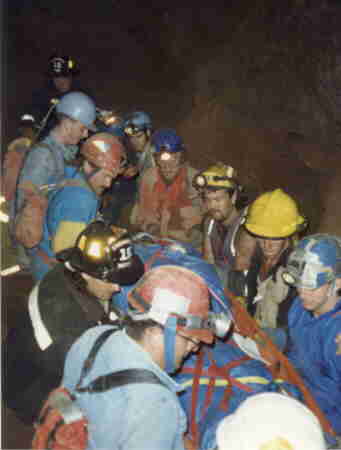
The Eastern Region of the National Cave Rescue Commission (NCRC) was holding one of its regular two-day Orientation to Cave Rescue classes in the Uniontown area. Saturday I was down to help teach the lecture portion of the class at the Hopwood Fire Department at the foot of Laurel Mountain. I had to work in the Mercy Emergency Department in Pittsburgh on Sunday, and so wasn't able to participate in the mock cave rescue scheduled for that day. The class was in the cave doing the mock rescue when a young woman fell about 15 feet and landed on her head near the back of the cave. She was lucky, because within a half-hour of her injury, she had a fully-trained NCRC cave rescue team there! (Talk about a fast response to a cave rescue.)
According to the note sent out by NCRC Wilderness EMT Julia Smith (the class hadn't set up wire and field phones as we do on real rescues), she was confused and combative, with blood coming out of her mouth, and seemed to have limb injuries possibly including a femur fracture. Jackie Bannerman, a long-time NCRC instructor who was working on the surface to coordinate the class, immediately started the proper coordination for a cave rescue. She called me at the ED and told me about the note; she asked me to respond to the scene to provide additional medical evaluation and treatment in the cave. Members of the local fire departments and rescue squads also responded to provide assistance.
I was getting ready to run up to the helipad and hop on the STAT Medevac helicopter when I noticed the expression on Eric Swanson's face. Eric, at that time a resident in emergency medicine, was the doctor on call for regular medical helicopter transport operations. The STAT BK-117 was really just giving me I ride, but I knew Eric had some mountain rescue experience, and had taught Wilderness EMT classes for the Center before. So I lent Eric some of my spare polypro underwear to put under his flight suit, and at the scene we borrowed a helmet and light for him, and he got to go along into the cave. Indeed, he did all the work, and I just supervised, just like in the ED <g>.
As it turned out, the patient's injuries weren't as bad as Julia suspected. No question of Julia's competence, indeed she's one of the best cave rescue medics in the world, it's just that it's sometimes hard to tell what the injuries truly are right near the time of the accident. Ask any epxerience paramedic or emergency physician or trauma surgeon; sometimes you just can't tell.
Anyway, Eric was able to determine that (1) she was now neurologically intact, (2) her injuries did not include any major long-bone fractures, just maybe some minor ones, and (3) she had no signs of any internal injuries. He then was able to clinically clear her cervical spine and get her out of the immobilization that was causing her such discomfort. He and I were then able to reassure the rescue leaders that the patient was entirely stable, and that they could manage the rest of the rescue at a more measured pace. As it was, one rescuer sprained an ankle and another suffered a minor head injury during the rescue.
Regardless of that, the patient was lucky -- first, to have a big trained and certified NCRC rescue team right there, and secondly, to have teaching-institution-quality emergency medical care at her bedside, in the cave. Indeed, we got some x-rays in the Emergency Department and confirmed her two minor fractures, the trauma service observed her overnight, and released her the next day.



Dr. Keith Conover of Mercy Hospital, and Dr. Eric Swanson, then of the University of Pittsburgh Affiliated Emergency Medicine Residency, later an attending in the ED at Mercy, later at Cottonwood Hospital in Utah, at the rescue, but happy to be back out of the cave.
You know, there was only one problem with this rescue. When the call first came in, I had run down to my car to grab my cave rescue gear to tote up to the helipad. But while there I had taken a minute to dump my dress shoes in the car and put on my caving boots. But when we got back to the ED after the rescue, I realized that I could change out of my caving clothes back into my dress clothes -- but still would have to wear my caving boots until I could get out to my car. Well, the cave was a really clean cave (for a cave) and so I ended up just wearing my caveralls in the ED, and even went out into the waiting room to talk with the patients' parents in my caving coveralls. Oh, well, live and learn.
 Go to Keith's Home Page
Go to Keith's Home Page Back to Keith's
SAR/Outdoor Page
Back to Keith's
SAR/Outdoor Page